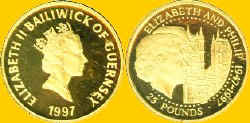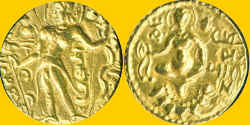This is the Worldwide Numismatics Website!
This is a modest collection of second millennium gold coins
Click the thumbnail picture to see a larger version of the picture, then use your browser BACK button to return to the original page you were viewing.
GREAT BRITAIN
Also known as the United Kingdom of England, Wales, and Scotland. The region was settled by European Celts around 800 BC and their languages (Gaelic and Brythonic) are still spoken in Scotland and Wales, respectively. The Romans invaded in 43 AD and took only seven years to quell resistance and control most of England. The Scottish and Welsh tribes were more of a problem, resulting in the building of Hadrian's Wall across northern England to keep out the marauding Scots. The Romans were never defeated but their influence just disappeared around 410 AD as their empire collapsed. Germanic tribes (Angles, Jutes and Saxons) moved in after Roman rule dissipated . By the 7th century, these fiefdoms had grown into a series of Anglo-Saxon kingdoms. By the mid-9th century, Vikings had invaded northern Scotland, Cumbria and Lancashire and the Danes were making inroads into eastern England. These invaders soon were assimilated by the English. William the Conqueror invaded the south coast of England in 1066. After his victory at the Battle of Hastings, he replaced English aristocrats with French-speaking Normans. Oliver Cromwell and Parliament seized power in the mid-17th century after deposing and executing the king. Order and the monarchy was restored in 1660.
During medieval times, most major cities in England hosted mint facilities. Private mints functioned from the late 1700s including Heaton and Kings Norton. The current government minting facility is located in Llantrisant Wales.
½ Laurel - 1619
KM-070
- 4,50 g
The obverse features a laureate bust of King James I (b1566-d1625) who also was King James VI of Scotland before union. His most notable achievement was the publication of the King James Version of the Bible in 1611 which is still the bedrock of most Protestant Christian denominations. The Latin legend IACOBYS D G IAC BRI FRA ET HIB REX. The reverse has the crowned royal arms with the legend HENRICVS ROSAS REGNA JACOB.
GREECE
The powerful Cycladic, Minoan and Mycenaean maritime civilisations flourished during the Bronze Age (3000-1200 BC). By 800 BC Greece was undergoing a cultural and military revival, with the evolution of city-states, the most powerful of which were Athens and Sparta. Greater Greece was created, with southern Italy as an important component. This period was followed by an era of great prosperity known as the classical (or golden) age. This age ended with the Peloponnesian Wars (431-404 BC) where Sparta defeated Athens. Meanwhile Philip of Macedon's kingdom in the north was gaining military power. Philip's son, Alexander the Great, fulfilled his father's plans when he marched into Asia Minor, Egypt (where he was proclaimed pharaoh and founded the city of Alexandria), Persia and parts of what are now Afghanistan and India. The reign of the Macedonian empire, lasted in the form of three dynasties after Alexander's death at the age of 33. There were Roman incursions starting around 205 BC, and by 146 BC Greece and Macedonia had become Roman provinces. After the subdivision of the Roman Empire into Eastern and Western empires in 395 AD, Greece became part of the illustrious Byzantine Empire. In 1453 the Turks captured the Byzantine capital, Constantinople, and by 1500 almost all of Greece had also fallen under Turkish control. A group of intellectuals led the War of Independence (1821-32), against the Ottoman Turks. Russia, France and Britain decided to intervene in 1827 finally defeating the Turks and instituting a monarchy which lasted until 1967 when the military instigated a coup d'etat. Greece was finally constituted as a Democracy.
Most city-states had minting facilities in the glory days of Greece and many of these continued to operate into the days of the Roman occupation. Modern Greek coins are minted in France, Austria, and the UK.
20
Drachma - 1884-A
KM-056 - 6,45 g
Mintage
- 0,550M
The obverse depicts a bareheaded image of King George (b1845-d1913) with the Greek legend GEORGIOS AI BASILEUS TON ELLHION, the date, the mintmark to the left and the designer's name to the right. The reverse features the royal arms of Greece encircled by the legend BASILEION THS ELLADOS with the denomination 20 DRACHMAI. To the left are the initials of the designer and to the right is the mintmaster's privy mark.
GUATEMALA
The area now known as Guatemala was inhabited by Mayan Indians when the Cortes sent his lieutenant, Pedro de Alvarado, to invade Guatemala in 1524. The colonies making up the Captaincy General of Guatemala declared their independence from Spain on September 15, 1821. Mexico under Emperor Agustin de Iturbide tried to annex the states in 1822. Iturbide was dismissed from office in 1823. The five states of El Salvador, Guatemala, Honduras, Nicaragua, and Costa Rica went on to establish themselves as the United Provinces of Central America on July 1, 1823, later to be called the Central American Republic. Continued problems between liberal and conservative forces finally led to the demise of the CAR. Guatemala formally declared itself a sovereign republic in 1847.
Guatemalan coins were minted in Neuva Granada and England at the Heaton Mint.
5 Quetzales - 1926
KM-244 - 8,36 g
Edge - Reeded
Mintage - 0,048M
The obverse has Guatemalan national arms with the country's name REPUBLICA DE GUATEMALA around the top and the date 1926 at the bottom. The reverse has a quetzal bird perched on a pillar that is inscribed 30 DE JUNIO DE 1871 with the Spanish legend LEY DE 26 DE NOVIEMBRE DE 1924 (Law of 26 September 1924) around the top. The denomination 5 is to the left of the pillar and QUETZALES below the pillar.
There are more Guatemalan gold coins in this section if you are interested - Page Guatemala 1
GUERNSEY (BAILIWICK)
The island was inhabited during the Iron Age. There is a a fort dating back to around 550BC. The Romans used the island as a trading base from around 56 AD and probably stayed here for around 250 years.
Guernsey
was an important trading point between France and England. The
Romans called Guernsey Sarnia. The "ey" ending on Guernsey is
the Viking word for island.
Christianity
was established in Guernsey in the 3rd and 4th centuries and St Sampson later
established a church in the island. The Bretons moved to the island from between
600AD and 800AD.
Islanders
proudly state that their ancestors were part of the forces of Norman the
Conqueror which defeated England in 1066. In fact since around 933, when Rollo's
son William Longsword added the islands to the dukedom of Normandy, the
inhabitants of these islands have been answerable only to the Duke of Normandy
and his successors, the British sovereign. When Guillaume Duke of Normandy
conquered England in 1066, he became King William I as well as Duke of Normandy.
However when King John lost the territory of Normandy to Philip II of France,
the Channel Islands remained loyal to the English crown. In return for this
loyalty, King John granted to the islands, certain rights and privileges in 1215
which enabled them to be virtually self-governing, subject only to Royal assent
and enactments through the Privy Council. In 1294 a large part of the Guernsey
population were killed in French raids. In fact over the ensuing centuries,
possession of the islands switched back and forth between the English and French
six times. Between 1338 and 1340, the French occupied Guernsey and seized Castle
Cornet, holding on to it for six years. Raids continued up to the end of the
1400s and in 1480 Pope Sixtus IV declared the island to be neutral.
At
the end of the English civil war, Guernsey petitioned the Monarchy pleading for
a Royal pardon in 1660. This was granted and all previous rights and privileges
were restored. In the 1600's privateering became commonplace and considerable
wealth started to build up in the islands. This was legalised piracy licensed by
the Crown to seize foreign ships. During the Reformation ,the islands swayed
between Catholicism and Protestantism. John Wesley visited Guernsey in 1787 and
Methodism flourished.
In the 1800's, wealthy French residents fleeing the revolution moved to Guernsey. In 1926 the English language was adopted and the island's currency linked to the British Pound.
During
1940-1945, Guernsey was occupied by German forces and huge numbers of defensive
positions were built as part of Hitler's Atlantic Wall. Of the population of
40,000 17,000 were evacuated to England.
£25 - 1997
KM-085 - 0,2509 g
Edge - Reeded
Mintage - 5.000
This NCLT coin was issued to commemorate the Golden Anniversary of the Queen and Prince Philip's marriage. The obverse has the Machin depiction of the Queen. The legend ELIZABETH II BAILIWICK OF GUERNSEY and the date 1997 circle the bust. The reverse has conjoined busts of the Queen and Prince Consort with Westminster Abbey in the background. The legend ELIZABETH AND PHILIP 1947-1997 and the denomination 25 POUNDS surround the image.
GUPTA EMPIRE
The Gupta Empire in 4th century AD is considered as the golden age of Indian history. The Guptas ruled India for more than two centuries. Chandragupta I was the first in the Gupta Dynasty to assume the imperial title of 'Supreme King of Kings'. He strengthened his position by a matrimonial alliance with Lichchhavis.
The greatest of all Gupta kings was Samudragupta whose campaign expanded the empire in all directions. Samudragupta was succeeded by Chandragupta II who was also known as Vikramaditya (380 ~ 413AD). He continued the policy of world conquest pursued by his predecessor by military activity and political marriages. Kumaragupta and Skandagupta succeeded him. Skandagupta was able to repel initial conquests by white Huns. But after his death the Huns spread rapidly towards the close of 5th century and the early 6th century. After the fall of Gupta Empire, north India broke into smaller kingdoms and never was really united until the arrival of Moslems.
During the Gupta Era, classical art forms emerged and treatises on grammar, mathematics, astronomy, medicine etc. were written.
1 Dinar - 380-414 AD
Fr-79b variety - 7,78 g
This coin was issued in the name of Chandragupta II. The obverse pictures King Chandragupta II standing with a bow in his left hand and an arrow in his right hand. The Marigin legend reads Deva Sri Maharajadhiraja Sri Chandragupta, with "Chandra" below the left arm. The reverse has the goddess Lakshmi seated facing cross legged on a lotus. The legend at the right reads Sri Vikramah.
If you would like to see additional gold coins, please click here - Page 14
If you want to return to the home page, please click here - Home

